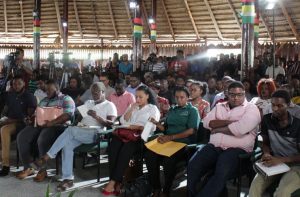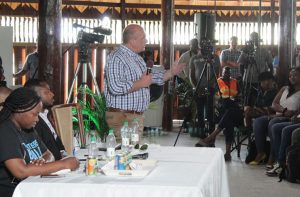SCORES of young people filled the Umana Yana on Saturday to learn more about Guyana’s oil and gas sector, particularly about the myriad of ways that they can contribute to and benefit from the sector.
The event was organised by the Department of Youth to encourage young people to align themselves with the industry.
“We as Guyanese have grown up in the era of rice, sugar, bauxite and gold and to us maybe we are conceptualising oil and gas in a similar way. We have to go beyond that– we have to begin to see this not only as a new industry, but also as a new way of doing business,” Director of the Department of Energy, Dr. Mark Bynoe highlighted.
According to Bynoe, the “old ways” of doing business may no longer be applicable.
There have been 10 deep-water discoveries in the Stabroek Block offshore Guyana and the estimated recoverable barrels of oil are in excess of five billion.
Bynoe told the gathering that the Floating Production Storage and Offloading (FPSO) offshore vessel should be within Guyana during the third quarter of 2019 and production will commence in the first quarter of 2020, when the first tranche of the projected US$300M revenue is expected.
LOCAL CONTENT
The forum was also created with the aim of raising awareness about the sector for young people, while providing a forum where they can air their concerns and suggestions or have any questions answered. Resultantly, the larger portion of the forum focused on interaction between the policymakers and the mammoth crowd of youth. The majority of the questions asked directed focus to local content.
“One of the first things that we need to understand is that the standards within this sector are astronomically higher than everything we have ever been exposed to,” the director said. “In managing this sector therefore, it is important that we have the requisite individuals and the department has been seeking those individuals wherever they are present.”
Furthermore, the director posited: “Knowing that there is a dearth of skills in Guyana for this particular sector, our wont has been to hire in expertise but to [also] seek to link those with expertise with Guyanese persons like yourself, so that capacity can be built as we move forward.”
Bynoe however sought to clarify later that this lack of skills is seen primarily in the actual oil and gas industry, but there are still a myriad of avenues for the promotion of local content.
He explained that there are four different levels of employment opportunities in the industry: Upstream activities, which involve actual exploration and production; downstream activities, which involve refining and processing the resources and product distribution; midstream activities, which are the nexus between upstream and downstream and include components such as transportation, and ancillary activities.
For young people and Guyanese as a whole, he urged that thought be given to the “multiplier effects” that may result from the industry and not just the opportunities found directly within the industry.
Lending credence to Bynoe was the department’s Oil and Gas Advisor Matthew Wilks, who has decades of experience in the field, worldwide.

“The oil and gas industry will include a certain amount of people. In general around the globe, what you find is that it doesn’t employ huge amounts [of people],” Wilks said.
However, he explained that the “real job opportunities” will spur from how the revenues accrued will be spent– whether on infrastructure, energy diversification or otherwise.
And though many are wary of Guyana’s joint agenda– to become a Green State and an oil-producing nation, Environmental Policy Coordinator of the Department of Environment Alvin Doris stressed that the young people should harness the opportunities presented therein.
According to Doris, young people can begin to think innovatively on how to prevent the environmental implications that may result from oil production.
“To date, more 60 per cent of persons directly employed in the oil and gas sector are Guyanese…Guyana has benefited directly to the tune of $65M US from local content in 2018 alone… [and] Guyanese are in all areas and they continue to be trained to be directly absorbed into the sector,” the director of energy nevertheless related.
Bynoe also highlighted that his department continues to engage with the operators to ensure that Guyanese do have a share in terms of first preference. In fact, he shared that ExxonMobil, the current operator, is mandated to report and develop an annual local content plan, which it has been doing.
“We cannot deny that when we start speaking about the upstream activities, there is not a single Guyanese who has built-in this country- an FPSO,” he contended but stressed: “We need to be able to ensure that we are positioning ourselves not for just one element, but there will be midstream, downstream and also ancillary activities.”
And for young people desirous of being considered for employment within the industry or to provide services, Dr. Bynoe urged them to register with the Centre for Local Business Development located on South Road.
“It wouldn’t guarantee [that you will be hired or subcontracted] but will help you to position yourselves, so that if anything is coming through, you will be considered,” the director said. He also highlighted that the centre also offers training to help equip locals.
“You don’t have to become a petroleum engineer to benefit from oil and gas; what you have to do is to ensure that you’re are a certifiable Guyanese, so that you can become employed,” he stressed. “As young people we have to continue to take every opportunity there is for training, skill building and certification. Plan for careers not only in oil and gas, but also for transformation for the Guyanese economy that is taking place and that is still to come.”
OIL REFINERY
Aside from local content, many persons at the forum were very much interested in whether Guyana would be building a local oil refinery as part of efforts to create business opportunities within the sector.
Dr. Bynoe noted that from the feasibility study done, it would not be feasible to build a refinery, given that the current oil finds are largely in deep-water areas. He however mentioned that this does not preclude private persons from pursuing that venture.

“Bringing the oil [from the deep waters] to shore in Guyana to refine is probably cost ineffective,” Wilks noted but added: “If we end up discovering oil close to shore in shallow waters, then a refinery starts to become more pragmatic and cost effective.”
At the youth forum, GuyEnergy’s Chief Executive Officer, Dr. Turhane Doerga nonetheless indicated that his company is looking to establish an oil refinery in Region 10, and purchase 17 per cent of the oil from the government.
To this end, Dr. Bynoe said that his department is tasked with managing the industry in an ‘optimal way’ and in so doing, he ruled out the possibility of a government-built refinery and said that government would not subsidise oil for private entities.
“If the feasibility analysis demonstrates that it is more feasible to do that moving forward, then we will do that,” he however added.



.jpg)









